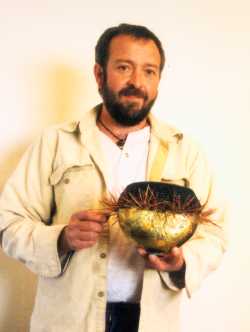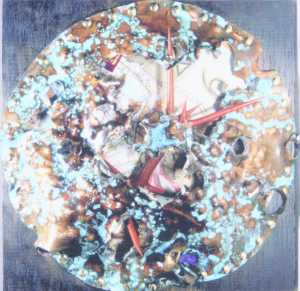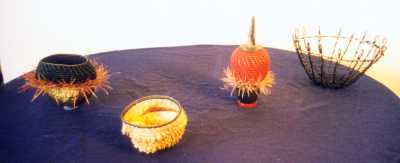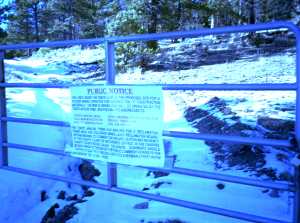Article by Sue Snively
Artist – May 2002 – Colorado Central Magazine
THE UNIQUENESS OF HIS ART speaks for itself. A Salida craftsman, Rod Porco uses mostly salvaged items to create his unusual vessels. Although there are elements of basketry in his work, the pieces are entities unto themselves, fashioned from discarded objects, broken scraps, plants, and other non-traditional materials. In one exquisite piece, Porco may combine thorns, gourds, pieces of copper, Venetian glass, and barbed wire.

Rod says his vessels “are in many ways, a reflection of my emotional and physical environment. Collecting broken and discarded artifacts and reassembling them, I work to define their function as visual.”
Porco takes “cold, hard and non-giving elements” and shapes them into guardian containers of great gentleness and beauty using the “vulnerable elements of space and soul.”
One of Porco’s vessels combines harsh thorns and woven telephone wire with broken Venetian glass and a sharp bison horn, yet it has an elegant beauty which makes it clear, as Rod puts it, “that thorns and roses do co-exist.”
One of his more striking pieces is called, “In the Violence of a Summer’s Dream,” and it’s Porco’s artistic interpretation of the tragedy of September 11, 2001. This very emotional piece is displayed in the American Crafts Museum in New York City.
Shortly after that fateful day, Betsy Kubie from Crafts of America asked Rod to submit a proposal for a memorial honoring the victims of 9-11 to be displayed in the museum with the work of other distinguished craftsmen. The requirements specified that the finished work had to be 6 inches by 6 inches and no more than 2 inches tall. By tracing the evolution of this piece, it is easy to get a feel for how Rod creates.
First, he took a 6″ by 6″ piece of oak, and used soot and shoe polish to blacken it. Then he found an old copper dish, and he and a friend went into the woods and shot holes through it. At home again, Rob hammered the dish back into a semi round shape, then cleaned the metal with soap and water, and soaked it in vinegar and salt. The next step was to fume the dish with ammonia to secure the beautiful blue color of the copper.
To complete the work, Rod collected pieces of map from New York, Pennsylvania and Washington, D. C., along with postage stamps, airline tickets, and broken pieces of mirror. He scorched the paper objects, then laid a clock face on the wood and scattered the maps, stamps, tickets and mirror shards mentioned above over the clock face on the surface of the black wood.
Then he overlaid the copper bowl, face down, over the many pieces, and secured it with nickel nails. Rod placed thorns through the metal, and positioned the bowl so that the numbers 9 and 11, and the map pieces, postage stamps, airline tickets, and mirror pieces are visible through the bullet holes.

THE FINAL PRODUCT is visually beautiful, but the ripped metal, scorched paper, shattered mirror shards, and prickly thorns reflect the tragedy and violence of that fateful day. The finished work expresses not only the emotional impact the tragedy had on Porco, but it also evokes impressions of the actual event. It’s a very powerful piece.
Porco, who was born and raised in the Arkansas Valley, started painting and drawing when he was young. He has an associate degree in Advertising Design from the Colorado Institute of Art in Denver, and a background in graphic design. But several years ago, he became interested in three-dimensional mixed media art — mainly because it has no limitations. You can use whatever you find and put it together however you want, blending the different mediums.
Porco’s work has been strongly influenced by the Native Americans in the area, particularly the Utes. After visiting the Ute Mountain Museum in Montrose, he was overwhelmed by the exquisite work shown in the many baskets and garments on display. The Ute’s choice of materials was mind boggling to him. Rod’s work doesn’t mimic traditional Ute crafts, in that it is fairly contemporary, but it does have primitive elements.
The Colorado Metalsmithing Association, of which Rod is a member, has also had an influence on his work. Rod remembers watching Eliot Pujol, a well known member of the group, at work and thinking how much fun he seemed to be having as he worked with metal.
In 2000, Porco’s career as a craftsman and artist really took off when he was juried into the Smithsonian’s 18th annual craft show, called “Crafts of the Millennium.” The show featured the handmade creations of 120 artisans in categories such as basketry, ceramics, fiber, metal, and wood. Rod’s work is still exhibited on the Smithsonian web site.
SINCE the Smithsonian show, Porco’s work has been shown at selected exhibits in numerous locations including Tacoma, Washington; San Francisco, La Jolla, and Redondo Beech, California; and Baltimore, Maryland. His work has appeared in Sag Harbor, New York, and at the Houston Center for the Contemporary Arts.
In June of this year, he will exhibit at the Society of North American Goldsmiths’ show, “Sculpture Attitudes” which will be held in conjunction with the organization’s “Show of Hands” Conference in Denver.
Following that, Porco’s next major exhibit will be in Pasadena, California. In 2003, Bongo Billy’s Salida Cafe has asked Rod to “fill up” one of their walls for the Salida Art Walk.

Numerous galleries display Porco’s work, including Gallery 150 in Salida, Obsidian Gallery in Tucson, and La Jolla Fiber Arts in La Jolla, California plus galleries in Massachusetts, Washington, and Connecticut.
Rod’s more non-traditional and “edgy” pieces now sell for between $200 and $1200 apiece.
Although Rod continues to do some work as a logger, art is becoming a major source of support for him. From the beginning, he knew that it was going to take time to establish himself, so he has followed the advice he gives to artisans just starting out: Rod Porco has worked hard and persevered, and he hasn’t been afraid to get his work out there.
As he says, “You never know what will happen, if you don’t try.”
Sue Snively of Buena Vista is a retired teacher who likes to bicycle, climb mountains, and ride motorcycles.


